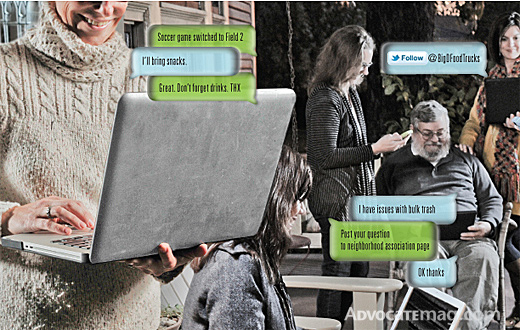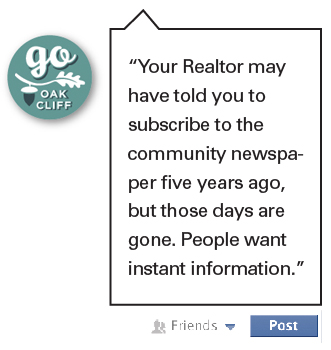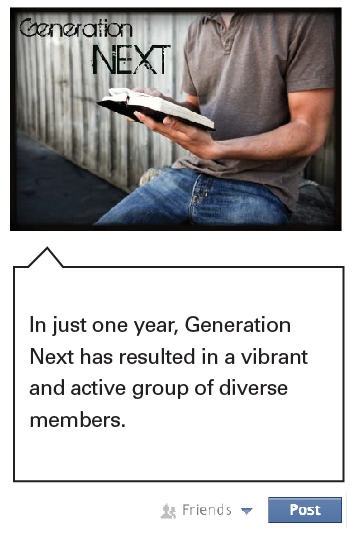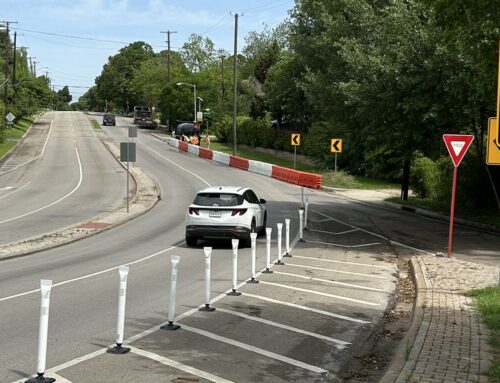The rise of social networking and virtual connections is changing things around here

Facebook is no longer just a silly tool for tracking down old flames or notifying the world that you are enjoying a fine sandwich. Along with other forms of digital interaction, organizations use Facebook to mobilize meetings and movements, reunite lost pets with owners, alert residents to prowlers and track down wanted criminals, to name a few. Social media can forge relationships, improve efficiency, boost business and promote safety within communities.
Of course, like any technology, it comes with a few pitfalls, and not everyone is on board.
• What’s a friend and a follow? Click here for a glossary of basic social media terminology you’ll see in this story.
• Read about how the Advocate is using social media.
• Get ideas about how social media can benefit your neighborhood organization, business or group.
iCommunity
Remember the dark ages? Back in the olden days, maybe a decade or two ago, when PTA members dialed phone trees to blast messages about field trips, dress codes and communicable illnesses. Neighborhood association presidents hand-delivered newsletters from door to door. And when a pet lost its way, owners plastered the neighborhood with “lost” fliers.
Some of those methods linger on, but now, in the digital age, social media has become an easy and effective way for neighbors to communicate.
Social media, of course, is nothing new. We’ve been using Facebook and other social media to find long-lost classmates and connect with new crushes or business contacts for what seems like ages now, although it was more like 2008 for most users.
In the past year or so, however, Facebook has become the new front porch, a portal for community. Neighborhood associations, local businesses, police and schools use social media to stay in touch, spread news and stay organized.
Neighborhood resident Amy Cowan, the dynamo behind Oak Cliff Mardi Gras, Cliff Fest and many more neighborhood events, says she can’t remember life before social media. A real estate agent friend tells her clients to “friend” Cowan on Facebook to stay hip to what’s up in North Oak Cliff.
“Your Realtor may have told you to subscribe to the community newspaper five years ago, but those days are gone,” Cowan says. “People want instant information.”
Cowan, who is a co-founder of Go Oak Cliff, says she thinks social media is more effective in reaching people than email or any other source. Emails go ignored, fliers are tossed, and newspapers are left unread. But social media is a way to “infiltrate” and get information to people who might not otherwise see it unless it’s in their Facebook or Twitter feed.
“Social media allows groups of people of similar interests to congregate without ever interrupting their regular schedules,” she says.
Using it allows her to check the latest on city council redistricting before she even gets out of bed, and to find traffic information on Twitter while sitting at a red light, for example.
The information she shares and receives via social media — from recommending a good dentist in Oak Cliff to learning the details of a friend’s job interview — is not always critical. But as a whole, it’s the fabric of community.
[youtube]http://www.youtube.com/watch?v=aP9pCC8v1Xw&list=UUZwOp37VTONKycATn4lB1Nw&index=1&feature=plcp[/youtube]
iReligion
 Neighborhood resident Catherine Dodge used social media to spark more interest in her church, Kessler Park United Methodist Church, among younger people. She joined the church in 2008, and even though she liked its progressive beliefs, she lost interest quickly because she didn’t make friends. The church has programs for children, families and seniors, but as a young single woman with no children, she found no niche for herself in the church.
Neighborhood resident Catherine Dodge used social media to spark more interest in her church, Kessler Park United Methodist Church, among younger people. She joined the church in 2008, and even though she liked its progressive beliefs, she lost interest quickly because she didn’t make friends. The church has programs for children, families and seniors, but as a young single woman with no children, she found no niche for herself in the church.
That’s what she told Rev. David Carr after he took over as pastor last year.
“He said, ‘What can we do to bring more people your age in? Because I know there are people like you who have had the same experience,’ ” Dodge recalls.
Her solution is called Generation Next, a social media push to introduce the church to younger, tech savvier people.
Without an online presence, “the church kind of didn’t exist for us because we find everything online,” she says. “You’re not really communicating with this large number of people.”
She started by updating the church’s website, which hadn’t been touched in about six years. She created a Facebook page, and she checks in on Facebook every Sunday to let her friends know where she is. Most people ages 25-40 won’t take an organization seriously if it doesn’t have an active website. And they are unlikely to find a new website unless it comes across their Facebook or Twitter feeds.
Dodge’s social media efforts paid off quickly. In just one year, Generation Next has resulted in a vibrant and active group of diverse members. Nowadays, most visitors say they find the church through Google searches. Best of all, reviving the church’s membership this way was inexpensive. Social media is a smart way to publicize a nonprofit that lacks funds for other forms of advertising, Dodge says.
iNeighborhood
Several Oak Cliff neighborhood associations have used the same tactics. The Winnetka Heights Neighborhood Association, for example, has kept an up-to-date website with chat forums for several years now. But the neighborhood association’s Facebook page, which has been active for less than a year, is a way to drive neighbors to that website. Hits to the site have increased significantly since the association started using Facebook, Winnetka Heights Neighborhood Association president Lee Ruiz says.
 “People are on Facebook so often and so regularly that information reaches people right away,” Ruiz says. “On the other hand, they have to think about going to the neighborhood web page.”
“People are on Facebook so often and so regularly that information reaches people right away,” Ruiz says. “On the other hand, they have to think about going to the neighborhood web page.”
Ruiz often posts links to information on the website regarding neighborhood parties, contests, and city hall and zoning issues, for example. Neighbors use the association Facebook page to alert neighbors to lost pets, property crimes, suspicious activity and more.
In Kings Highway, neighborhood association leaders have used social media to organize workdays and fundraisers. A tag sale in September drew shoppers from all over the city, thanks to social media blasts.
Neighbor Jonathan Braddick says social media is the first place to look to find out what’s going on in the neighborhood. But, he says, it’s a mistake to go away from print media advertising entirely.
“If we have the money, we will go with tried and true print media,” he says. “If we can afford it, which usually we can’t, we like to do direct mail.”
iCrime Fighting

Dallas Police YouTube channel • youtube.com/ DallasPoliceDept • Dallas Police post surveillance videos of crimes on the DPD YouTube channel. The popular video-sharing site allows police to seek the public’s help in identifying suspects as well as locating missing people and solving various types of cases.

iWatch App • dallaspolice.net • The iWatch app provides three options: Send in a text only, send in a text with a picture, or send an anonymous tip. You can also text a tip by typing DPD plus your tip to 274637, or you can call 214.671.4TIP.
A heavyset, bearded man recently went on a robbery spree in Dallas. A security camera captured the guy holding up a Game Stop clerk. A few hours later, the Dallas Police Department had shared the video with its 400 YouTube subscribers, 8,000 or so Facebook fans and 7,000 Twitter followers. The police also posted the suspect’s image and other useful information about the search on Nixle, a nationwide network that alerts residents to public safety threats via text, Twitter or email (anyone can register free for Nixle alerts by zip code).
“I saw this guy at the train station,” wrote one Facebook user.
“He sure is ugly,” wrote another.
Though it gives them a certain amount of junk to sort through, and the Game Stop robber at the time of publication had not been caught, police say enhanced communication can only help an investigation and encourage more people to help.
“It’s a way of getting involved without getting too involved,” Sgt. Israel Herrera says about both social media tools and the relatively new crime-fighting tool iWatch. The smart phone application allows users to give anonymous tips to police. The Dallas Police Department reports that since its launch last January, it has received about 1,135 iWatch tips, many leading to arrests
iBusiness
Social media is not just a pastime for neighborhood resident Porsha Thomas. It’s her business. The 25-year-old operates public relations firm Zora Ellison Writing Co., and she says about 80 percent of her work is social media. Local companies and organizations, including the Bishop Arts District Merchants Association, pay her to post social media updates about them.
“There are people who know they need Facebook, but they don’t understand it,” she says. “My clients are either people who understand it and don’t have time, or people who don’t understand it.”
She often designs event posters that are never printed. They’re used only on Facebook. Posting pictures and interacting with customers in social media is a valuable service, Thomas says. When she posts pictures for one of her clients, The Gypsy Wagon, people who “like” the page often post to ask whether it comes in their size.
“They don’t even call the store,” Thomas says. “They just ask on Facebook if we have it.”
Most trendy businesses in Oak Cliff maintain a steady presence on social media. Lockhart Smokehouse’s Twitter followers are the first to know when the barbecue joint offers its beef ribs special. Oak Cliff Bicycle Co. can showcase its latest gear on Facebook, and its page serves as a touchstone for the cycling community. Use Foursquare to check in at the Texas Theatre and get $1 off a large popcorn.
Oddfellows restaurant uses social media to promote events such at happy hour and “taco Tuesdays.” Cowan, who is an Oddfellows co-owner, says she thinks the restaurant was popular immediately because the owners used social media to promote it long before it opened. They showed the community, through Facebook, how they were transforming the space and creating the menu.
“People watched us transform a space and grow a business via social media,” she says. “They felt like they were part of the process.”
iDallas
Four city hall web functions you probably haven’t used (but should)
 1. Check out library books to your mobile device.
1. Check out library books to your mobile device.
dallaslibrary.lib.overdrive.com
Not only does the Dallas Public Library have a thorough and useful app (with the swipe of a finger, search the catalog, place items on hold or renew items checked out) but it also has an extensive selection of eBooks available to borrow. Options range from New York Times bestsellers (John Grisham’s “The Litigators”) to classics (Ayn Rand’s “Atlas Shrugged”) to popular nonfiction (Michael Pollen’s “The Omnivore’s Dilemma”). We tried it, and in less than 10 minutes, we were reading on our iPhone. A helpful guided tour takes library cardholders through the process.
2. Find out whether your favorite restaurants passed inspection.
Go to page on dallascityhall.com
They wouldn’t be open if they hadn’t, but the section located at this lengthy web address allows you to see whether the places you frequent are receiving high scores or barely making the grade. A quick search by name reveals how a restaurant fared on its most recent inspections.
3. Run into Mark Cuban, Ebby Halliday or the Cowboys cheerleaders.
These local celebs are a sampling of the famous names and faces the Dallas Park and Recreation Department recruited to promote its recent trail etiquette campaign. Other than watching the amusing video, website visitors can view an interactive map to find the exact layout of Dallas trails (both current and planned) in relation to streets, rec centers and other local landmarks.
4. Learn which park pavilion beat out Cowboys Stadium as the 2009 “Best of Show” award recipient from the American Institute of Architects Dallas chapter.
This little-known fact is touted in the online brochure “The Park Pavilions of Dallas,” which highlights 44 of the city’s shade-giving structures. Thirty-two of them were designed by respected architects who were charged with making the pavilions “contextual within the surrounding community and embraced by the neighborhood,” among other criteria.







